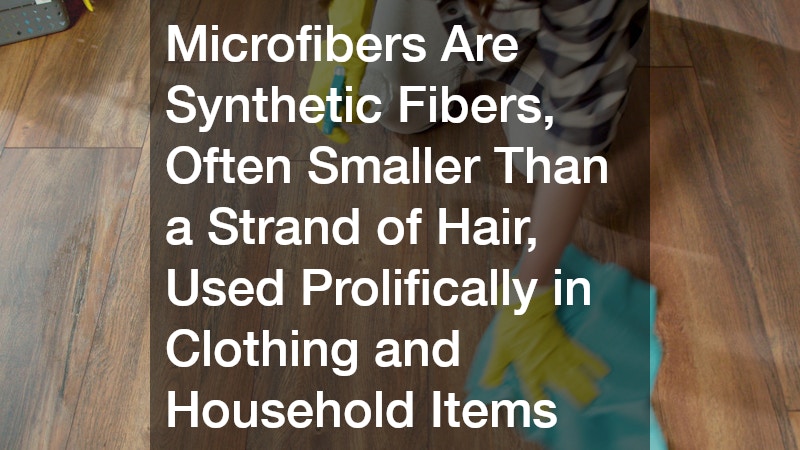Microfibers have become an integral component of modern textiles, but their presence extends far beyond our wardrobes. Understanding what microfibers are and their rampant production is crucial as their implications on the environment and society are profound. They matter because their ubiquitous nature leads to widespread environmental concerns, surfacing in places where we least expect.
As society continues to demand sustainable practices, it is essential to delve into the realm of microfibers and recognize their impact.
What Are Microfibers?
Microfibers are synthetic fibers, often smaller than a strand of hair, used prolifically in clothing and household items. Composed primarily of polyester and nylon, they are manufactured through a process that entails melting plastic pellets and forcing them through fine holes to create threads. This method allows manufacturers to tailor the fibers’ characteristics, such as texture, strength, and flexibility, making them popular in diverse applications.
While the development of microfibers has revolutionized apparel with their durability and comfort, it has simultaneously introduced a persistent environmental challenge. Approximately 60% of clothes material stems from synthetic fibers like microfibers, highlighting their critical role in fast fashion trends. As these garments endure wear and tear, microfibers are released into the air and water, contributing to environmental pollution at an unprecedented scale.
The widespread use of microfibers is a double-edged sword, serving both economic purposes and ecological disruption. The industry thrives on producing affordable, versatile materials, yet the consequences of microfiber waste go largely unchecked. Understanding the lifecycle from production to post-consumer waste disposal is vital in addressing microfiber pollution and its deeper impact on ecosystems.
How Do Microfibers Affect the Environment?
The journey of microfibers extends into natural ecosystems, where their impact is notably detrimental. Water bodies are particularly vulnerable, as fibers shed in laundry processes pass through sewage systems and end up in rivers, lakes, and oceans. Here, marine life, ranging from the smallest plankton to larger ocean predators, ingests these fibers unwittingly, mistaking them for food. This not only affects individual organisms but also disrupts entire food chains, causing a ripple effect that threatens biodiversity.
Environmental pollution from microfibers is exacerbated by their propensity to act as carriers for toxic chemicals. These fibers latch onto pollutants like pesticides and heavy metals, facilitating their entry into aquatic environments. As a result, microfibers contribute to chemical pollution, raising serious concerns for human health, particularly for communities whose diet depends heavily on seafood. Mitigating this risk requires urgent attention to microfiber pollution management.
Microfibers’ presence in soil further denotes a pressing environmental challenge. As these fibers settle into the earth, they hinder plant growth by altering soil composition and nutrient uptake. This diminishment in soil health can have far-reaching consequences for agriculture and food security. Addressing microfiber pollution, therefore, requires a holistic approach to mitigate its multifaceted impact on the environment.
Ways to Reduce Microfiber Pollution
Reducing microfiber pollution necessitates a combination of technological innovation, behavioral change, and regulatory support. One way to combat this issue is by implementing effective filtration mechanisms in washing machines, which capture microfibers before they enter wastewater systems. These filters, while not yet standardized, can significantly cut down the fibers released per wash, and their adoption needs encouragement through incentives and legislation.
As consumers, adopting sustainable fashion choices plays a pivotal role in minimizing microfiber emissions. Purchasing high-quality garments designed for longevity reduces the likelihood of fiber shedding. Additionally, choosing natural fibers like cotton and wool over synthetic alternatives can help curb microfiber pollution. Practices such as hand washing clothes and lowering wash temperatures also mitigate fiber release, contributing to more sustainable laundry routines.
On a larger scale, policy interventions are essential in driving systemic change. Governments and organizations must work collaboratively to establish guidelines that enforce accountable production processes and encourage sustainable practices. Research funding directed towards developing biodegradable synthetics and improved waste management systems is crucial. Public awareness campaigns are instrumental in educating the masses about microfiber pollution, fostering a culture of responsibility and sustainability.
Microfibers are an insidious yet pervasive aspect of our material culture, whose production and disposal demand urgent attention. We have explored their definition, environmental impact, and practical solutions to reduce their presence in our ecosystems. Addressing microfiber pollution is not just an environmental imperative but a societal responsibility, pivotal to ensuring healthier ecosystems and communities. As awareness grows, so does the potential for change—ushering in a new era of sustainable living that respects ecological boundaries.

